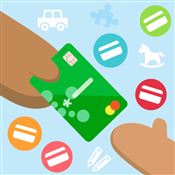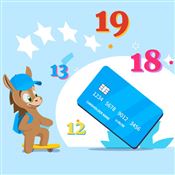Best Free Debit Card for Kids and Teens
Are free debit cards for kids safe and legit? Compare the top 9 best free debit cards for teens and kids under 13.
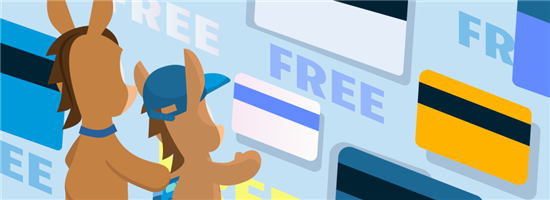 |
Here are the top 9 free debit cards for kids and teens:
- Step Banking for building credit
- Axos First Checking for teenagers
- Chase First Banking for kids under 13
- Capital One Money Teen Checking for ATM access
- Mazoola for easy sign up
- Current Teen Banking for saving and charity
- Till Financial for iPhones
- Nationwide First Checking for online banking for teens
- Alliant Credit Union Teen Checking for interest checking account
Step Visa Card for Teens
- Building credit is safe and easy with the Step secured Visa card
- Step Black members earn 3.00% on savings and up to 10% cashback on purchases
- No interest, no security deposit and no credit check
Remember when piggy banks were the only way kids could learn how to save?
Yeah, a piggy bank just doesn't cut it anymore.
This rule helps parents remember the key aspects to consider when choosing a debit card for their kids:
- Deposit: Easy to load money onto the card.
- Independence: Allows kids to manage their own money.
- Monitor: Parents can monitor spending and set limits.
- Educate: Provides educational tools for financial literacy.
Today, it's more obvious than ever that financial literacy is a huge key to success. With modern debit cards for kids and teens, it's easy to teach kids how to save, spend wisely, and even invest.
With a slew of free debit cards available, which ones are actually worth your time? Find out how the 9 best free debit cards for kids compare. Plus, learn how to choose a safe account for your family.
Here are 5 paid debit cards for kids and teens you may want to consider:
- Greenlight for investing
- Acorns Early (formerly GoHenry) for financial education
- FamZoo for teaching about interest
- Jassby for rewards program
- BusyKid for younger kids
Greenlight Banking and Investing for Kids
- Chores and allowance tools
- Up to 6% APY on Savings
- Up to 1% cashback on purchases
- Invest in stocks and ETFs with no trading fees
- $5.99 to $24.98 per month per family, for up to 5 kids
Free Debit Cards for Kids and Teens
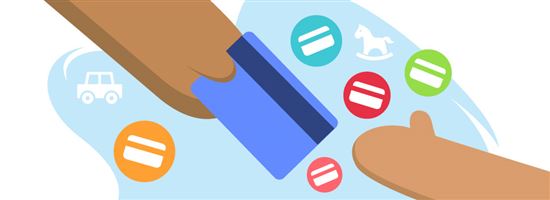 |
Ready to give your child real-world experience with managing money? Check out these debit cards for minors, including options for kids ages 13 years and younger.
Step Visa Card for Teens
- Building credit is safe and easy with the Step secured Visa card
- Step Black members earn 3.00% on savings and up to 10% cashback on purchases
- No interest, no security deposit and no credit check
Children under 18 can't open their own bank account. But parents can open a checking account for their kids. Learn more about how to open the right checking account for your child.
Step Banking: Build Credit for Teens
| Age | No minimum |
|---|---|
| Price | $0 |
| Apple App Store | |
| Google Play Store | |
| Key Features | Visa debit card; build credit; direct deposit; savings goals; parental controls |
Step Banking offers a free Visa debit card for teenagers. It comes with a contactless Visa card that can be used with Apple Pay and Google Pay. Parents can monitor spending and transfer money to their child.
Although there's no age limit to use Step, the app is best suited for teens. The account comes with direct deposit, peer-to-peer payments, and no overdraft fees. But its most unique feature is credit building for kids.
The Step Visa Card lets minors build positive credit safely. Transactions will contribute to your kid's credit history, but your kid can only spend the amount in their account. There's no way to overspend, no interest, and no monthly payments.
Your kid can withdraw money at 30,000 ATMs for free. But there's no way to add money to an account at an ATM. You can only fund through a linked bank account, debit card, or direct deposit.
Account Details
- Minimum Deposit to Open: $0
- Daily Transaction Limits: $1,000 debit, $500 Google Pay/Apple Pay, $250 ATM[1]
- Card Replacement: Free
Step Visa Card for Teens
- Building credit is safe and easy with the Step secured Visa card
- Step Black members earn 3.00% on savings and up to 10% cashback on purchases
- No interest, no security deposit and no credit check
Axos First Checking: Best for Teenagers
| Age | 13 - 17 years old |
|---|---|
| Price | $0 |
| Apple App Store | |
| Google Play Store | |
| Key Features | Debit card; earn interest; mobile check deposit; direct deposit; bill pay; ATM fee reimbursement; parental monitoring |
Axos First Checking is a joint checking account with a free debit card for teens. The account earns interest and supports direct deposit, bill pay, and peer-to-peer payments. It functions a lot like a regular checking account, so it's great for teens who are ready to take personal finance seriously.
You won't find any educational content or chore-assigning function in the app. But it's a great choice for teenagers who need a reliable checking account and debit card. The card can be used online or in-store, and it can be added to a mobile wallet.
Think of Axos First Checking like a bike without the training wheels. The account offers your kid more financial freedom than other apps. Parents can monitor spending activity through the app, but not control it.
As an established online bank, Axos has dependable security features. Your kid's account will have anti-virus and malware protection, 2-step authentication, SSL encryption, and more.
Account Details[2]
- Minimum Deposit to Open: $50
- Daily Transaction Limits: $500 debit, $100 ATM
- ATM Fee: Up to $12 reimbursed per month
- Card Replacement: Free
- Expedited Card Delivery: $50
Learn More: Axos Bank Review
First Checking - 0.10% APY
- Joint checking account for 13-17 year olds
- No fees
- Up to $12 domestic ATM fee reimbursements per month
For more of our top picks specifically for teenagers, read on debit cards for teens.
Chase First Banking: Best for Kids Under 13
| Age | 6 - 17 years old |
|---|---|
| Price | $0 monthly service fee |
| Apple App Store | |
| Google Play Store | |
| Key Features | Visa debit card; savings goals; chores and allowance; Chase ATM access; parental controls and monitoring |
Chase First Banking is one of the best debit cards for kids with $0 monthly service fee. This account lets your kid access their money online, in-store, and at 15,000+ Chase ATMs. Your kid can use their card anywhere Visa is accepted.
The Chase First Banking app is powered by Greenlight, a popular paid banking platform for kids. The apps share some similar features. This includes chore lists and allowance setup, robust parental controls, and customizable savings goals.
There is a catch to this otherwise solid free debit card—it's not open to everyone. Parents can only set up an account if they're a current Chase checking customer. You'll need to link your Chase checking account to your kid's account to make deposits.
Overall, it's still a great choice for a free, full-featured banking app and debit card for your child.
Account Details
- Minimum Deposit to Open: $0
- Daily Transaction Limits: $400 debit, $100 ATM[3]
- Non-Chase ATM Fee: $3 fee per withdrawal at a non-Chase ATM in the U.S. and the U.S. territories. $5 fee per withdrawal at a non-Chase ATM outside of the U.S. and the U.S. territories. Surcharge Fees from the ATM owner/network still apply. U.S. territories include American Samoa, Guam, the Northern Mariana Islands, Puerto Rico and the U.S. Virgin Islands.
- Foreign Transaction Fee: 3%
- Card Replacement: Free
- Expedited Card Delivery: $5
Learn More: Chase First Banking Review
- Chase Total Checking
- Chase Secure Banking
- Chase Business Checking
Capital One Money Teen Checking: Best ATM Access
| Age | 8 years and older |
|---|---|
| Price | $0 |
| Apple App Store | |
| Google Play Store | |
| Key Features | Mastercard debit card; earn interest; easy transfers; 70,000+ fee-free ATMs; parental controls and monitoring |
Capital One Money is a beginner's checking account for kids ages 8 and up. The app is a bit more basic compared to some competitors. There are no chore lists or educational content. But the app works well for saving, setting up allowances, and monitoring your kid's spending.
The platform has one of the best ATM networks on this list. Your kid can withdraw or deposit money at more than 70,000 fee-free locations. If your kid needs to deposit cash or checks frequently, this could be a great option to consider.
Capital One Money lets your kid earn some interest. Your kid's account balance won't grow much since the rate is quite low. But it could be a way for you to introduce your kid to the idea of compound interest.
Account Details
- Minimum Deposit to Open: $0
- Daily Transaction Limits: $500 debit, $500 ATM[4]
- Card Replacement: Free
- Expedited Card Delivery: $25
Mazoola: Easy Sign Up
| Age | No minimum |
|---|---|
| Price | $0 |
| Apple App Store | |
| Google Play Store | |
| Key Features | Virtual debit card; chores and allowance; robust parental controls and monitoring |
Mazoola is a free virtual debit card for kids and teens. The virtual card can be used online or linked to a mobile wallet for on-the-go use. Since the account only comes with a virtual card, signup is quick and easy. You can use the account right away without waiting for a card to come in the mail.
Parents can set up money transfers for completed chores or as a reward for good behavior. Within the app, your kid can set up personal goals and fundraising goals for charities.
Mazoola is COPPA compliant, which helps protect your child's privacy online. The platform takes privacy and security seriously. Since there's no physical card, there's no risk of it falling into the wrong hands.
Funding options are limited with Mazoola. Parents can transfer funds from their linked bank account. But it does not support cash, check, or direct deposits. It also doesn't come with ATM access, which can be an issue if your kid needs to withdraw cash.
Account Details
- Minimum Deposit to Open: $0
- Daily Transaction Limits: $3,000 debit[5]
Current Teen Banking: Best for Saving and Charity
| Age | 13+ years old |
|---|---|
| Price | $0 |
| Apple App Store | |
| Google Play Store | |
| Key Features | Prepaid Visa debit card; instant money transfers; savings goals and roundups; chores and allowance; charity donation; parental controls |
The Current Teen Banking account helps teens take control of their money and grow their savings. Unlike some accounts that only support one funding source, Current lets multiple family members easily fund the account.
The Visa debit card lets teens easily access their money. But parents have complete control over how much freedom their kids have. The app offers great parental control options, including spending limits and merchant blocking.
Current also has a few clever features to help your teen save money. Your kid can set up separate "pods" for saving and donating money to charity. The roundups feature will round up purchases to the nearest dollar and the difference is automatically transferred to your kid's savings.
While most debit cards for kids come with a fee, the Current Teen Banking doesn't charge a monthly or annual fee.[6] There are no overdraft fees, transfer fees, and minimum balance fees.
Account Details[7]
- Minimum Deposit to Open: $0
- Daily Transaction Limits: $2,000 debit, $500 ATM[8]
- Out-of-Network ATM Fee: $2.50
- International ATM Fee: $3 + 3%
- Foreign Transaction Fee: 3%
- Card Replacement: $5
Learn More: Current Review
Convenient Teen Account With Debit Card
- Easy transfers, set spending limits, automate allowances
- Age: 13 years and older
- Fees: No monthly or annual fee
Till Financial: Best for Teaching Teens to Budget
| Age | 8 - 18 years |
|---|---|
| Price | $0 |
| Apple App Store | |
| Google Play Store | |
| Key Features | Virtual and physical Visa debit card; chores and allowance; matching contributions; savings interest contributions; parental controls |
Till is a physical and virtual debit card that helps parents and kids collaborate to make smart money decisions. Till offers the common features of kid banking apps, like chores lists, savings goals, and parental controls. But it also has a few interesting ways for parents to send kids money.
Parents can choose to match a percentage of their kid's savings contributions or even pay a custom interest rate on their savings account. You can choose the percentage and how often you want to pay interest.
Unfortunately, the account itself doesn't pay any interest. On the bright side, you can bump up the interest rate for a more dramatic demonstration of how compound interest works.
Account Details
- Minimum Deposit to Open: $0
- Daily Transaction Limits: $2,500 debit, $250 ATM[9]
- Card Replacement: $5
- International ATM Fee: $5
- Foreign Transaction Fee: 3%
New User: $25 Bonus using the voucher code CREDITDONKEY
New users will get a $25 bonus credited to their account when the kid makes their first purchase using their Till card using the voucher code CREDITDONKEY
Nationwide First Checking: Online Banking for Teens
| Age | 13 - 17 years old |
|---|---|
| Price | $0 |
| Apple App Store | |
| Google Play Store | |
| Key Features | Debit card; earn interest; mobile check deposit; direct deposit; bill pay; ATM fee reimbursement; parental monitoring |
Nationwide First Checking is a great choice for a free teen debit card. The account earns some interest, which is rare in a free banking app for kids. The account is powered by Axos Bank, so it's pretty much the same as Axos First Checking.
Both accounts are great options for teenagers who need a legit checking account. The debit card can be used online, in-store, and in a mobile wallet. Plus, it's easy to fund the account through bank transfers, direct deposit, and mobile check deposits.
The interest rate on this account isn't very high. But it's a good way to start teaching your kid about earning interest. If you're in the market for a free debit card for your teen, Nationwide First Checking is a great option.
Account Details[10]
- Minimum Deposit to Open: $50
- Daily Transaction Limits: $500 debit, $100 ATM
- ATM Fee: Up to $12 reimbursed per month
- Card Replacement: Free
- Expedited Card Delivery: $50
Alliant Credit Union Teen Checking: Best Interest Checking Account
| Age | 13 - 17 years |
|---|---|
| Price | $0 |
| Apple App Store | |
| Google Play Store | |
| Key Features | Visa debit card; earn interest; ATM fee reimbursement; parental monitoring |
Alliant Credit Union Teen Checking is a great way for parents to teach kids how to use a checking account. Parents can monitor spending and set up notifications. But the account gives your teen more freedom than some other banking accounts for kids.
The Teen Checking account offers one of the highest interest rates in a free debit card for teens. You can earn interest each month if you opt in to eStatements and set up one recurring monthly deposit to the account.
The account comes with a contactless Visa debit card for you and your teen. Plus, Alliant has a network of more than 80,000 fee-free ATMs. If you can't get to an in-network ATM, Alliant also reimburses up to $20 in ATM fees per month.[11]
There are quite a few fees to look out for. (You can view the full fee schedule here.) But most of the fees can be easily avoided.
Account Details
- Minimum Deposit to Open: $0
- Daily Transaction Limits: $500 debit (PIN-based transactions), $5,000 debit (signature-based transactions), $500 ATM
- ATM Fee: Up to $20 reimbursed per month
- Card Replacement: Free ($10 fee for excessive losses)
- Foreign Transaction Fee: 1%
- Stop Payments (submitted in writing or verbally): Free
- 1-year Inactivity Fee: $10
Top 5 Paid Debit Cards for Kids and Teens
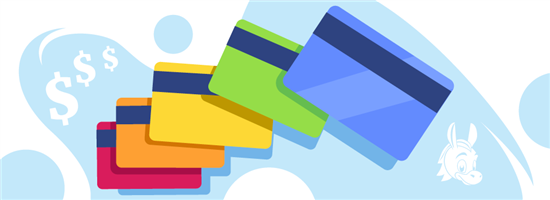 |
Free debit cards for kids are obviously a great value. But if you want more advanced features, like investment services, be sure to check out your paid options.
Are these debit cards worth the monthly fee? Compare these top 5 banking apps for kids and teens to find out.
Greenlight: Best for Investing
| Age | No minimum |
|---|---|
| Price | Greenlight Core: $5.99/mo.; Greenlight Max: $9.98/mo., Greenlight Infinity: $14.98/mo. |
| Apple App Store | |
| Google Play Store | |
| Key Features | Prepaid Mastercard debit card; in-app educational content; investment account; high savings reward; cash back; chores and allowance; parental controls; personalized card |
Greenlight is a banking app and debit card that teaches kids about all the fundamentals of personal finance. Your kid can get experience earning interest, getting cash back, and even investing.
With all these extra features, you will pay a steeper price. But the monthly fee covers up to 5 kids. If you have a larger family, Greenlight could still be a good deal. You can choose from 3 different plans:[12]
- Greenlight Core ($5.99/mo.): Includes kids' debit card, basic banking, educational content, parental controls, financial literacy games, credit card for parents, investing for parents with limited features, and 2% savings reward.
- Greenlight Max ($9.98/mo.): Adds an investing platform and research tools for kids and parents, priority customer support, protection plans, cash back on purchases, and 3% savings reward.
- Greenlight Infinity ($14.98/mo.): Adds family location sharing, crash detection, SOS alert, cash back, and 5% savings reward.
The app includes videos and quizzes that break down important financial topics like budgeting and investing. If you're looking for a platform that can help your kid learn the fundamentals of finance, this is a great choice.
Account Details[13]
- Minimum Deposit to Open: $1 by bank transfer or $20 by debit card
- Daily Transaction Limits: $1,500 debit,[14] $100 ATM[15]
- Card Replacement: $3.50 (first replacement free)
- Expedited Card Delivery: $24.99
- Custom Card Fee: $9.99
Learn More: Greenlight Review
Acorns Early (formerly GoHenry): Best for Financial Education
| Age | 6 - 18 years old |
|---|---|
| Price | $5/child to $10/family |
| Apple App Store | |
| Google Play Store | |
| Key Features | Prepaid Mastercard debit card; fun, educational games; chores and allowance; parental controls; personalized card |
Acorns Early (formerly GoHenry) is designed to make financial literacy fun for kids. But it really shines for tailoring its content to your kid's age.
Younger kids learn how to earn, save, and spend wisely. Teens get more mature content and lessons to help them become confident with advanced topics like investing and entrepreneurship.
This app doesn't actually include an investment account. But it stands out by making financial education more engaging for kids and teens. The Money Missions feature feels like a game and is packed with helpful information.
Acorns Early costs $5 per month for the individual child. The app also offers an affordable family plan, which is $10 per month and covers up to 4 children.[16] If you have a larger family, this might be worth the cost. It's a solid choice for parents who want flexible controls and good in-app content.
Account Details
- Minimum Deposit to Open: $5
- Daily Transaction Limits: $2,500 debit, $120 ATM
- ATM Fee: Free
- Card Replacement (same design): Free
- Card Replacement (different design): $5
- Custom Card Fee: $5
Learn More: Acorns Early (formerly GoHenry) Review
Acorns Early Kids' Debit Card
- Real-time spend notifications.
- Block and unblock cards easily.
- Teach financial independence safely.
FamZoo: Best for Teaching About Interest
| Age | No minimum |
|---|---|
| Price | $5.99/mo. |
| Apple App Store | |
| Google Play Store | |
| Key Features | Prepaid Mastercard debit card; subaccounts; family billing; parent-paid interest; chores and allowance; parental controls |
FamZoo offers a lot of functionality in a debit card and banking app for kids. There's no age limit to use the account, but it's best for older kids and teens. In addition to common features like savings goals and chores lists, FamZoo has quite a few unique features.
Family billing lets you set up recurring charges to your kid for their expenses. There's also a feature that lets you lend money to your kid and charge interest. These tools teach a valuable lesson in learning how borrowing and spending money can affect their financial goals.
FamZoo is designed to help kids understand how money works in the real world. One downside is that the app doesn't offer investment services, so look elsewhere (like Greenlight) for those features.
The app costs $5.99 per month for up to 4 kids. You have the option to pay up to 24 months in advance and get FamZoo for as little as $2.50 per month.[17] This makes FamZoo one of the best deals in a kid debit card if you have several children.
Account Details[18]
- Minimum Deposit to Open: $5
- Daily Transaction Limits: $5,000 debit, $510 ATM[19]
- Additional Card Fee: $3.00 (after first 4 free cards)
- Card Replacement: $3.00 (first 2 replacements free)
- Expedited Card Delivery: $25
- Cash Reload Fee: Up to $4.95[20]
Learn More: FamZoo Review
FamZoo Prepaid Card for Kids and Teens
- Order Online
- No Credit Check
- Try for Free
Jassby: Best Rewards Program
| Age | No minimum |
|---|---|
| Price | $5.95/mo. |
| Apple App Store | |
| Google Play Store | |
| Key Features | Digital and physical debit card; rewards/shopping program; chores and allowance; parental controls |
Jassby is a debit card and app with a rewards program. Your kid gets a Financial Literacy Score based on their money habits. Higher scores earn higher rewards. These rewards can be redeemed for products and gift cards—including items from Apple, Starbucks, and Target.
The digital card can be used with Apple Pay, Google Pay, and Samsung Pay. A physical card is available upon request and Jassby will send it in the mail. The initial physical card for each family member is free but there is a $4.95 (+ applicable tax) fee for replacing it if your card is lost or stolen.
Jassby is less versatile than some of its competitors since you can't use the debit card to withdraw or deposit cash at an ATM.
Account Details
- Minimum Deposit to Open: $0
- Daily Transaction Limits: $1,000 debit[21]
- Card Replacement: $4.95 (+ applicable tax)
BusyKid: Best for Younger Kids
| Age | 5+ years old | |
|---|---|---|
| Price | $4 per month (billed annually at $48) | |
| Apple App Store | ||
| Google Play Store | ||
| Key Features | Prepaid Visa debit card; chores and allowance; savings and charitable giving; investment account; parent approvals |
BusyKid is another great option for parents who want an account that includes investing. Your kid will receive a Visa debit card and earn money by completing chores on the app. The platform encourages kids to save for personal goals and for charitable donations.
Kids can make donations to more than 50 charities right in the app. They can even purchase fractional shares from companies like Apple, Disney, and Facebook. Of course, parental approval is required before each transaction goes through.
Unlike some accounts at this price point, BusyKid doesn't offer a lot of parental controls. Parents need to approve money transfers between their kid's savings and spending sections. But you won't be able to set specific spending limits.
BusyKid costs $4 per month (billed annually at $48).[22] This price covers up to 5 children, so it's great for large families.
- Minimum Deposit to Open: $0; $10 minimum to invest
- Daily Transaction Limits: $2,000 debit (single transaction), $810 ATM[25]
- Declined Purchase Fee: $0.50
- Buying / Selling Stock: $0 commissions
- Foreign Currency Conversion: 3%
- Foreign Transaction Fee: $2.50
- Card Replacement: $5
- ATM Fee: $1.50
What to Look for in a Debit Card for Kids
 |
When choosing a debit card for your kid, there are a lot of factors to consider. Take some time to decide which features are most important to you. It'll make it much easier to compare your options if you already know what you want.
Here are some important factors to consider in a debit card for kids and teens.
Monthly Fee
Price is an important factor when you're shopping for any product, especially when it comes to a banking product. Luckily, you don't have to spend a lot of money to get a debit card for your kid. There are plenty of free options that work great.
Spending money for an account that's supposed to help your kid learn about saving can feel counterintuitive. But you might want to pay for an account if it offers the features you want. For a monthly fee, you could get extra functionality like investments and unique ways to save.
Parental Controls
As a parent, you want your kid to grow and learn freely. But, of course, you're also realistic. If your kid is new to managing money, you don't want to give them free rein of a credit card just yet.
Most debit cards for kids have some way for you to track your child's transaction history. Many debit cards often come with robust parental controls as well. It all depends on the amount of flexibility you want.
Some apps let you set limits for different spending categories and block specific merchants. Others may require parental approval whenever money is moved from savings to checking.
It's important to figure out what level of control you want over the account. Be sure to choose the option that makes you and your child feel safe.
Miscellaneous Fees
Most of the debit cards in this article have no monthly maintenance fees. But that doesn't mean that there are zero fees associated with the account.
You may encounter ATM fees, overdraft fees, foreign transaction fees, and card replacement fees. Some of these might be more common than others, but it's good to know how much you might have to pay.
These little fees can add up. If you visit the ATM often or use the debit card abroad, keep these factors in mind as you shop around for an account.
Privacy and Security
A good debit card will have security measures in place to keep your kid and your money safe. Measures like SSL encryption and strong authentication can give you a lot more peace of mind.
Some debit card accounts go even further to make your family feel safer. Advanced features could include identity theft protection and purchase protection in case of damaged or stolen items.
Always take a look at the app's privacy policy to see how your child's information will be used. Under COPPA, any apps geared toward children need to do their best to protect your child's confidentiality. Companies can still share data with third parties, however.
It's always good to stay informed and understand how apps are collecting and using data.
Chores and Allowance
Many banking apps for kids include features to pay allowances for chores. Usually, you can add chores to the app and assign dollar amounts for each completed task. If you have multiple kids, it's a great tool to keep track of all those household chores and payments.
These tools give your child a chance to really earn their money. It's a lot more effective to show your kids how valuable a dollar is, rather than just telling them. Plus, it's rewarding to watch your kids become more motivated to help around the house.
If you don't want to assign specific amounts to each chore, you can still use chore lists as a helpful organizational tool.
Educational Content
Some apps offer a wide range of tools, but not enough explanation of why the tools are important. Look for apps that teach your kids how to understand their finances and spending habits.
Educational content helps break down big concepts for your kid. You might find in-app videos, quizzes, games, or short articles. This content is designed to be bite-sized and entertaining—perfect for the TikTok generation.
Not every debit card app offers a library of educational content. But most apps will offer helpful insights into your kid's spending and savings habits. Your child will be able to see how their money habits have real-life consequences.
Investment Account
No matter how old your child is, now is the best time to give your kid a head start. It's never too early to start investing for your child's future. The longer investments have to grow, the better.
Kids under 18 can't open their own investment account. Debit cards, like Greenlight and BusyKid, offer investment services to help parents buy stock for their kids. Kids can choose which companies they want to invest in. But it's up to the parents to approve each transaction.
If you'd rather invest in index funds or ETFs, you could also consider a custodial investment account like Acorns Early Invest. This is an easy, set-it-and-forget-it type of investment that can grow over time.
Direct Deposit
Direct deposit is an important feature for teens who are navigating their first jobs. It's a lot easier than depositing a check each time your kid gets paid.
If your kid is very young, you might not be thinking about direct deposit just yet. Your little one isn't staying little forever, though! Before you know it, your kid will be picking up their first summer job. When the time comes, a debit card that supports direct deposit will be essential.
A paper paycheck could work fine, but getting paid straight to your account is much more convenient. Some debit cards can even help your kid get their paycheck up to 2 days earlier. Plus, it eliminates the possibility of misplacing a hard-earned check.
Savings Goals
Debit cards allow your kid to easily spend their money. But the best debit cards for kids also emphasize the importance of saving money.
Your kid can create savings goals within the app, then watch their progress over time as they save up. Be sure to encourage your kid to set specific goals, preferably within a set timeline. This helps your kid understand exactly what they're working toward.
This is great practice for adulthood since it touches on the fundamentals of saving: setting realistic goals and figuring out how to hit those goals.
For the most part, free debit cards for kids have pretty low interest rates on savings. You won't expect to find a lot of high-yield accounts. Still, any form of savings will help your kid or teen learn how to set aside money each month.
Interest Payments
Compound interest is powerful. It can turn a small credit card balance into a mountain of debt. Or, it can help money in an investment account grow exponentially over time.
The best way to introduce this concept to your kid is through real-life experience. Not many kid debit cards offer high interest rates. Many don't earn any interest at all. However, there is a cool feature that can simulate an interest-earning account.
Parent-paid interest lets you pay your kid a percentage you set based on how much your kid saves. This can encourage your kid to save more often. But it also clearly illustrates how money can grow if you let your interest earn interest.
ATM Access
Cash isn't completely obsolete yet. Even though online banking is big right now, you'll want to consider how easy it is to withdraw or deposit cash from your account.
Perhaps you and your family rarely deal with cash or checks. If that's the case, you don't have to worry about ATM access so much. It's still a nice feature to consider in emergencies where your kid needs to get cash in a pinch.
Find out if your debit card charges any fees for ATM transactions. It really depends on the company, so be sure to compare multiple options. Also, pay attention to the daily ATM limits. It might be disappointing if your family planned for a big purchase that goes over the limit.
Charity Donations
Money isn't just about spending and saving for personal use. For many families, charitable giving is a huge part of responsible money management. If you want to teach your kid to be compassionate and financially smart, charity is a great teaching opportunity.
Donating to causes you care about feels good and does good in the world. Debit cards with charity donations built in make it easy for your kid to save some of their money for giving.
The benefits here are twofold. Your kid will learn to identify causes they're passionate about. And in-app savings features help your little one budget for every donation.
Pros and Cons of Kids' Debit Cards
Pros
- Learn money fundamentals from a young age. Let's face it. Most school educations don't emphasize personal finance nearly enough. Teaching your kids about money management early on will give them invaluable tools for life.
- Better security and convenience. A debit card and banking app combo makes it easy to transfer money to your kid. A debit card helps your kid safely spend money in person and online. Even if the debit card is lost or stolen, it can quickly be deactivated to prevent unwanted transactions.
- Stop carrying cash. Kids can be forgetful or a little careless when it comes to loose change and bills. Going fully digital or using a debit card ensures your child will always have money in case of emergencies.
- Start investing earlier. Some debit card accounts offer investing as well. This is a great head start toward financial freedom. Your kid will thank you when they enter adulthood with an investment account in their name.
- Get real-life experience. There's only so much you can learn by reading articles and watching YouTube videos. Real learning happens in real life. When your kid sees how their money changes over time, they'll appreciate its value even more.
- Flexible parental controls. If you're nervous about giving your child more financial freedom, debit cards are a great way to keep tabs on your kid. Many apps offer a lot of flexibility to limit spending and monitor your kid's habits.
You won't have to constantly check over your kid's shoulder to see what they're doing. And you'll have full control to make sure they're making smart decisions.
Cons
- Difficult to load cash. Many debit cards for kids don't have the option to deposit cash directly into the account. You'd have to deposit cash into the funding bank account first, then transfer it to your kid's account.
Some debit cards support cash deposits. But since a vast majority of kid debit cards support online banking only, it can be slim pickings.
- Easy to spend money. This could be a pro or a con, depending on how responsible your kid is. Kids and teens could overspend since a debit card makes it so easy to access their money. But this usually isn't a huge problem because many debit cards come with customizable parental control options.
- Account fees. Some parents might be reluctant to open a kid's debit card with a monthly fee. Depending on whether the fees cover just one child or multiple children, it can get a bit pricey. Luckily, there are many fantastic free debit cards you can get for your whole family.
Even on free debit cards, you might run into ATM fees or card replacement fees.
- Fewer choices for kids under 13. Kids age 13 and older have the most options for debit cards. If your kid is younger than 13, it can be a little more difficult finding an account.
Debit Card vs. Prepaid Card
Debit cards and prepaid debit cards are pretty similar. A debit card lets you access funds in a checking account at a bank or credit union. The debit card can access any of the money that's in the account.
Prepaid debit cards, on the other hand, need to be loaded with money before you can use it. Prepaid debit cards aren't linked to a bank or credit union account.
Which card type should you choose? Both have their pros and cons.
Teen debit cards work more like a traditional bank. Your kid could enjoy lower monthly fees and larger ATM networks. Plus, it can be nice to go with a trusted, reliable bank rather than a new financial app.
That said, teen debit cards usually have fewer features than prepaid debit cards. For example, prepaid cards may not include parental controls to adjust your child's spending. Some debit cards rely solely on daily transaction limits to curb your kid's spending.
Prepaid cards generally offer more flexibility when it comes to parental controls. Many apps give parents lots of options to control how often and how much their kid can spend. Unfortunately, prepaid debit cards for kids usually cost more than regular debit cards.
No matter which account type you decide to go with, rest assured that you'll be able to stay in the know about your kid's finances. Account alerts and notifications are pretty common in banking apps for kids.
How to Open a Children's Debit Card
If you're ready to open a free debit card for your kid, you're in the right place. Signing up for a debit card for teens and kids is pretty straightforward.
Specific requirements differ between each account, but here's some information you might need to get started:
- Full name
- Phone number
- Email
- Address
- Date of birth
- Social Security number
- Driver's license
- Your child's information
The process to open an account might vary between each kid's debit card. In general, here's what to expect if you want to create an account for your child:
- Go to the company's website or download the app.
- Click sign up to create an account.
- Fill out form with your personal information and your kid's information.
- Confirm your details.
- Select and order your debit cards.
- Receive your card in the mail in about a week.
If you don't want to wait long to receive your debit card, some companies offer an expedited shipping option. Keep in mind this can get very pricy. It's best to plan ahead to avoid the expedited shipping fee.
Some debit cards are available digitally before the physical card even arrives. You can use your digital card online or add it to your wallet to use Apple Pay or Google Pay.
How to Teach Your Kids About Money
 |
Learning about money is a lifelong journey. Your kid will continue to improve their understanding of personal finance as they grow older.
Not sure how to start talking to your kid about money? Here are 5 good places to start:
Lesson 1: Money Doesn't Grow on Trees
Yes, it's a cliché, but it's a cliché for a reason. When kids are young, banks, ATMs, and credit cards truly seem like endless sources of infinite money. It's up to parents to show them where money really comes from.
You can explain to your kid that you need to work hard for your money. Banks and ATMs simply store the money for you.
This is where an app with a chores and allowance function can come in handy. You can act as your kid's employer and pay them based on the work they've done. The earlier kids make the connection that getting money takes work, the better.
Lesson 2: Make a Wish
A wish list, that is. When your kid starts having some money of their own, it's tempting to spend it all on little knickknacks or snacks. By making a wish list, your kid is writing down bigger goals to save toward. And it feels a lot more fun than just calling it a list of savings goals.
Encourage your kid to write down multiple items on the list. The point is to come up with a bunch of things that your kid can't afford all at once. Then, discuss which items are most important and which can be put on the back burner.
This is a great exercise in learning how to reprioritize what's most important. It also helps your kid learn delayed gratification. Once your kid has enough money saved up for their top wish-list pick, it'll feel like a huge victory.
Lesson 3: Keep Tabs on Your Money
Where does your kid's money all go? Teaching your kid how to track expenses will set them up for a lifetime of success. Understanding what categories you spend the most on is a part of building a fully functional budget.
Show your kid how to read through past transaction history and identify any problem areas. Spending too much on games or junk food? Explain to your kid that reducing spending in one area can help them grow in a different area (savings, investments, etc.).
Lesson 4: Wants vs. Needs
Here's another budgeting fundamental that's perfect to teach kids: identifying wants vs. needs. This can sometimes be tricky even for adults, so it's best to start them off young.
It can be helpful to brainstorm together about wants vs. needs. This can help your kid think critically about what they really need money for.
With a debit card, your kid won't be able to overspend. The amount in the account is all your kid can spend. Once your kid realizes that money isn't magically replenishing in the account, it's time to make a plan.
Setting a simple budget, like a 50/30/20 budget, can help give structure to your kid's finances. This budgeting method allocates 50% of your money for needs, 30% for wants, and 20% to savings and debt repayment. (In this case, just savings. Hopefully, your kid isn't in debt.)
Lesson 5: Staying Out of Debt
Heavy debt is debilitating for many adults. That's why teaching your kids about debt early can be a worthwhile endeavor.
Let your kids know that they should only use their credit card if there's enough money in their checking to cover the cost of the purchase. Otherwise, they're spending money they don't have!
Most teen debit cards don't allow you to spend more than in the account. But you can use it as a tool to show your kid how quickly money can deplete if you're not careful. Make it a habit to regularly check your account balance and plan for future purchases.
Some debit card apps have a feature where you can charge "bills" to your children. Explain to your kid that there needs to be extra money in the account to cover the bills. There should be no surprises at the end of the month.
What to Do If Your Child Loses Their Debit Card
- Navigate to card settings in your debit card's app.
- Lock missing cards ASAP to prevent unwanted purchases.
- Order a replacement card.
- Pay any replacement fees if applicable.
- Receive your new card in the mail.
If your child loses their debit card, don't panic. Most debit cards come with an app that gives you total control over your account, including locking any missing cards.
From the app, you'll likely be able to cancel the card and order a new one. Some debit cards are free to replace; others will cost a one-time fee. The fee usually isn't more than $5, which isn't too bad if your kid doesn't make a habit out of it.
This is just one example of why it's better to give your kid a debit card instead of cash. A debit card can easily be canceled and replaced. Cash? Not so much. Once your kid loses cash, there's no easy way to recover it.
Frequently Asked Questions
What kind of accounts can I open for my kid?
There are a range of different bank accounts and investment accounts you can open for your kid. These include:
Checking
These accounts come with a debit card for your kid to access their money. This is a great place for your kid to earn money through allowances or direct deposit. You can access your money easily and securely without spending more than there is in the account.
Savings
Savings accounts help your kid put away money for the future. This is perfect for building an emergency fund or starting to build general savings. Some accounts earn interest to boost your kid's savings.
Others might not offer interest, but allow parents to pay interest based on their kid's savings amount. Either way, it can teach a valuable lesson about how interest grows over time.
Custodial Account
Uniform Gift to Minors Act (UGMA) and Uniform Transfer to Minor Act (UTMA) accounts allow parents to invest on behalf of their kids.[26] There are no contribution limits or income limits. Parents can deposit and withdraw money as long as it's for their kid's benefit.
Educational Account
Coverdell education savings accounts (Coverdell ESAs) and 529 plans are designed to help parents save and invest for their kid's education. Funds in these accounts can only be used for your kid's education only. A 529 plan is tax advantaged, similar to an IRA.
Credit Card
Kids can't apply for their own credit cards. But you could add them as an authorized user to your card. This can help your kid build positive credit by the time they're an adult.
Credit cards require a good deal of maturity and trust. Make sure your kid understands that they can't spend more than they actually have.
Are debit cards for kids safe?
When opening an account for your kid, it's crucial to do your research. Look for debit cards with these important features to keep your kid and your money safe:
FDIC or NCUA Insurance
Be sure any banking services you sign up for are insured by the FDIC or NCUA. The FDIC is a government agency that protects your bank deposits up to $250,000. If the bank fails, your money will be protected. The NCUA offers the same protection for credit union accounts.
COPPA Compliance
COPPA, the Children's Online Privacy Protection Act, requires apps for children to disclose what data is collected. Take a look at each app's privacy policy. They should clearly detail the personal data they collect and how they use your kid's data.
Parental Controls
Parental controls are key to feeling safe and confident about your kid's spending habits. Most kid debit cards have some sort of parental controls in place. This could include spending limits and merchant restrictions.
Some accounts, on the other hand, are more lax with their parental controls. There are apps that require parental approval for every money transfer, but don't offer spending limits. Decide how much flexibility and control you want, then choose an account that fits your needs.
Account Security
Financial apps should have multiple security measures in place to keep your sensitive information safe. Features like two-factor authentication, SSL encryption, and automatic logout usually come standard to protect your account.
Can my 11-year-old have a debit card?
Parents often wonder how old their kid needs to be before they can get a first debit card. The short answer is: it depends. Many banking apps offer debit cards for younger kids, with no minimum age to get started. Some accounts require that your teen is at least 13 years old.
Every account is different. Be sure to double-check the age requirements for the debit card you're interested in.
If your kid is younger than 13, rest assured you'll have plenty of options to choose from. Many banking apps and debit cards were even created with younger kids in mind.
Will a debit card affect my teen's credit score?
Using a debit card shouldn't affect your teenager's credit score at all. Debit cards are a safe way for your teen to learn about spending and saving money responsibly. Your kid will only be able to use the funds that are in the account.
One exception to this is the Step card, which works like a hybrid debit and credit card. This card helps kids build credit while only spending the amount that's in the account
Another option if you want to help your teen build credit is to add them as an authorized user to your own credit card.
Should I choose a credit card or debit card for my teen?
Credit cards and debit cards are both powerful tools when used correctly. Whether you should choose a credit card or debit card for your teen depends entirely on how mature and trustworthy your teen is with money.
Credit cards are good for building a positive credit history. Teens under age 18 can't open a credit card for themselves. But parents can add a kid as an authorized user to their account. The kid will receive a card in their name to make purchases that are linked to their parent's account.
If either you or your kid racks up a lot of debt or misses payments, both your credit scores could take a hit.
If you're not sure your teen is ready for the responsibility of a credit card, a debit card is a great alternative. There's no risk of your teen spending more money than they have. As an extra level of protection, most teen debit cards have done away with overdraft fees.
However, your kid won't build credit with a regular debit card. Your teen can, however, learn a lot about smart money decisions that will prepare them for their first credit card.
Can my kid get a Chime card?
Chime is a banking app with a free debit card, checking, and savings account. Chime is not available for children—you need to be 18 years or older to open an account.
Chime doesn't currently support joint accounts or secondary cards, so you can't add a child to your account. But the company has stated that they are working on adding this feature in the future.
Bottom Line
Kids catch on fast and form habits quickly. If parents don't start teaching their children about money, they'll learn it from somewhere else. And there's no telling what kind of information they can stumble upon online.
Give your child the best head start by opening a free debit card designed for teens and kids. These accounts are full of helpful features like savings goals, spending limits, and fun, educational content.
Before you choose a debit card for your kid, consider what functionalities you both need. Then, narrow down your search to find the best debit card and app for your family.
First Checking - 0.10% APY
- Joint checking account for 13-17 year olds
- No fees
- Up to $12 domestic ATM fee reimbursements per month
FamZoo Prepaid Card for Kids and Teens
- Order Online
- No Credit Check
- Try for Free
Acorns Early Kids' Debit Card
- Real-time spend notifications.
- Block and unblock cards easily.
- Teach financial independence safely.
Convenient Teen Account With Debit Card
- Easy transfers, set spending limits, automate allowances
- Age: 13 years and older
- Fees: No monthly or annual fee
Want to learn more about kid and teen debit cards? Check out these other articles about money tools for kids:
References
- ^ Step. Adding Money: Are there limits to how much I can withdraw, deposit and send?, Retrieved 7/26/2023
- ^ Axos Bank. Personal Deposit Account Agreement and Schedule of Fees, Retrieved 7/26/202
- ^ Chase. Additional Banking Services and Fees, Retrieved 3/22/2022
- ^ Capital One. MONEY Teen Checking Account Disclosures, Retrieved 3/22/2022
- ^ Mazoola. Consumer Interest Checking Account Agreement, Retrieved 3/22/2022
- ^ Current. Teen Account (No Monthly or Annual Fee), Retrieved 3/22/2022
- ^ Current. Deposit Account Agreement: Fee Schedule, Retrieved 7/26/2023
- ^ Current. Are there any limits to my Current account?, Retrieved 3/22/2022
- ^ Till Financial. Till Deposit Account Agreement, Retrieved 3/22/2022
- ^ Nationwide. Deposit Account Agreement: Fee Schedule, Retrieved 7/26/2023
- ^ Alliant. Does Alliant rebate fees if I use an out-of-network ATM?, Retrieved 3/22/2022
- ^ Greenlight. Plans, Retrieved 3/22/2022
- ^ Greenlight. List of all fees for Greenlight Prepaid Mastercard, Retrieved 7/26/2023
- ^ Greenlight. Are there funding and spending limits for my account?, Retrieved 3/22/2022
- ^ Greenlight. How much can I withdraw from an ATM per day and per month?, Retrieved 3/22/2022
- ^ Acorns. Acorns Early: Pricing, Retrieved 11/30/2024
- ^ FamZoo. Pricing, Retrieved 3/22/2022
- ^ FamZoo. Fee Disclosures, Retrieved 7/26/2023
- ^ FamZoo Prepaid Card FAQs: Are there any amount or frequency limits on card usage?, Retrieved 3/22/2022
- ^ FamZoo. Fee Disclosures, Retrieved 3/22/2022
- ^ Sutton Bank. Jassby Cardholder Agreement, Retrieved 3/22/2022
- ^ BusyKid. Features & Pricing, Retrieved 1/11/2023
- ^ BusyKid. Fees Schedule and Transactions Limits, Retrieved 7/26/2023
- ^ BusyKid. FAQ's: What Are Terms, Conditions & Fees of The Spend Card?, Retrieved 7/26/2023
- ^ BusyKid. Cardholder Agreement Busykid Spend Card, Retrieved 7/26/2023
- ^ "What is a UGMA or UTMA account?": HelpWithMyBank.gov, 2021.
Donna Tang is a content associate at CreditDonkey, a credit card comparison and reviews website. Write to Donna Tang at donna.tang@creditdonkey.com. Follow us on Twitter and Facebook for our latest posts.
Note: This website is made possible through financial relationships with some of the products and services mentioned on this site. We may receive compensation if you shop through links in our content. You do not have to use our links, but you help support CreditDonkey if you do.
|
|
| ||||||
|
|
|








